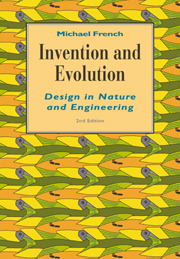Book contents
- Frontmatter
- Contents
- Preface to the second edition
- Preface to the first edition
- Acknowledgements
- 1 The designed world
- 2 Energy
- 3 Materials
- 4 Mechanism
- 5 Structures
- 6 Systems
- 7 The practice, principles and philosophy of design
- 8 Economy, form and beauty
- 9 Production, reproduction, evolution and design
- 10 Designing and inventing
- 11 Some case studies
- Questions
- Answers
- Suggestions for further reading
- Index
6 - Systems
Published online by Cambridge University Press: 06 January 2010
- Frontmatter
- Contents
- Preface to the second edition
- Preface to the first edition
- Acknowledgements
- 1 The designed world
- 2 Energy
- 3 Materials
- 4 Mechanism
- 5 Structures
- 6 Systems
- 7 The practice, principles and philosophy of design
- 8 Economy, form and beauty
- 9 Production, reproduction, evolution and design
- 10 Designing and inventing
- 11 Some case studies
- Questions
- Answers
- Suggestions for further reading
- Index
Summary
A third manifestation of design is in systems – combinations of components or organs for performing particular functions. Thus, the digestive system of an animal consists of jaws and teeth, salivary glands, gullet, stomach, and so on, and its function is to process food and extract from it the substances which support life. A railway system consists of railwaymen, rails, rolling stock, signals, and so on, and its function is to move people and goods.
These two examples of systems are of characteristic types. The digestive system is a process plant, in effect, where material flows through and is processed to yield some useful product or products. It has a series or line arrangement of components, one after another, and a flow from one end to the other. The railway system is a service system, which provides a function, transport in this case, over an area. It has a network of components, with flows in both directions down any branch.
Not all systems will fit into these two categories, but they do provide the key to a number of important aspects of design in which the ideas of flows, lines, loops and networks are central.
Process plants
A radio receiver displays many of the features of the process plant type of system. It consists of a large number of components, resistors, capacitors, coils, transistors, etc., connected into circuits by circuit boards and wires.
- Type
- Chapter
- Information
- Invention and EvolutionDesign in Nature and Engineering, pp. 147 - 179Publisher: Cambridge University PressPrint publication year: 1994

